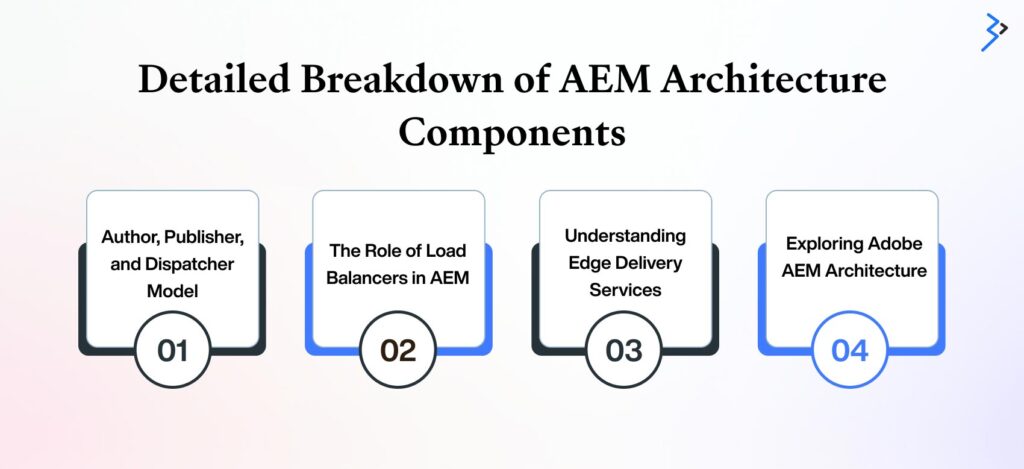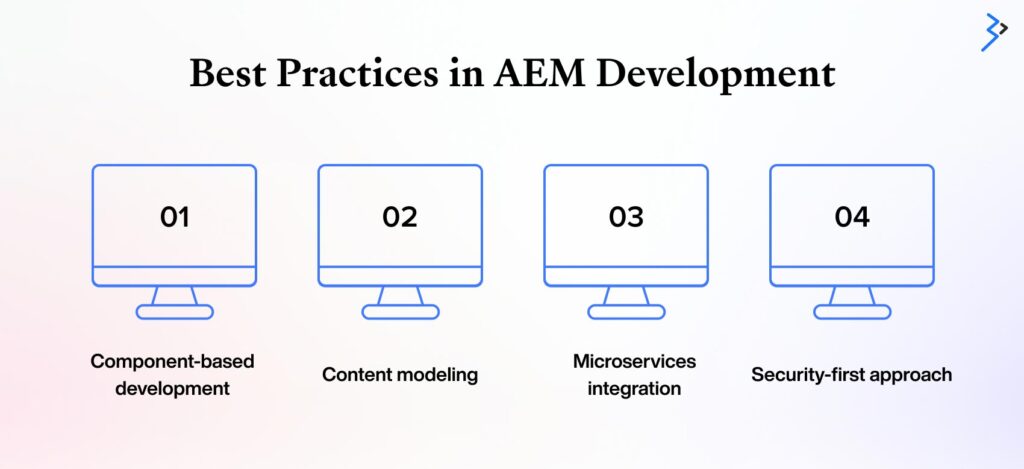Adobe Experience Manager (AEM) is a towering stronghold of innovation in today’s digital world, where content reigns supreme and user experience is everything.
However, like any magnificent construction, its essential strength is its architecture. Consider AEM a wonderfully built metropolis, with each component working in tandem to provide a seamless digital experience.
This tutorial will take you on an expert’s tour through the different aspects of Adobe AEM architecture, revealing the secrets that have made it the foundation of modern content management and digital experience platforms.
Introduction to Adobe Experience Manager (AEM) Architecture
Adobe Experience Manager Services, or AEM for short, is a comprehensive content management system that is the foundation for many enterprise-level digital experiences. At its heart, the Adobe AEM architecture is built to be strong, scalable, and adaptable to the complex needs of today’s digital environment.
Consider AEM architecture as the nervous system of a digital creature. It’s an intelligent network that analyzes data, organizes content, and provides experiences across several touchpoints. This architecture is based on Java technology and uses open-source frameworks such as Apache Felix OSGi and Sling.
The brilliance of AEM’s architecture rests in its modular design. Like building blocks, AEM’s components may be changed, expanded, or replaced to fit unique business requirements. This versatility distinguishes AEM from other content management systems and digital experience platforms.
At the highest level, the AEM architecture consists of many essential layers. Each is critical to the overall operation of AEM, collaborating to form a unified system capable of handling everything from content generation and administration to tailored content distribution across numerous channels.
Understanding the complexities of the AEM architecture is critical for developers, architects, and business leaders alike. Knowing how to utilize the platform is not enough; you also need to understand the underlying structure that makes AEM such a formidable instrument in the digital arsenals of top businesses worldwide.
Read More – What is the Navigation in Adobe Experience Manager
Detailed Breakdown of AEM Architecture Components

The Adobe AEM architecture is a wonder of current content management systems, built to handle complex digital experiences with simplicity and speed. To comprehend the strength of this system, we must examine its essential components. Adobe Experience Manager’s architecture is based on a firm basis that assures scalability, speed, and adaptability.
Author, Publisher, and Dispatcher Model
At the heart of the AEM architecture are key components that provide seamless content management and delivery. AEM architecture comprises three core components, namely:
- Publish Instance:
When the material is ready for the public to see, it is moved to the published instance. Publish Tier: The publish tier contains authorized and finished publicly available site material. This Adobe AEM system architecture component is designed to deliver high-performance content to end users.
- Author Instance:
The author layer is where content production teams create, organize, and update web pages and upload material. This is where the magic starts in the Adobe Experience Manager architecture. Content creators, designers, and marketers combine to create compelling digital experiences. The author instance offers a straightforward content creation, editing, and administration interface.

- Dispatcher:
The dispatcher, the underappreciated hero of the AEM design, plays a critical role in increasing performance and security. Dispatcher’s Role: Dispatchers are responsible for caching pages and load balancing to provide a speedy site experience. By caching static material and serving as a first line of protection against possible security risks, the dispatcher keeps your digital experience quick and safe.
Read More- Elevate your Adobe Experience Manager Sites Website with Generative AI Chatbots
The Role of Load Balancers in AEM
Load balancers are the traffic directors of the Adobe AEM architecture, ensuring that no one component is overloaded with requests. Load Balancer Function: Load balancers distribute traffic evenly among author, publisher, and dispatcher instances. This task allocation is critical for ensuring good availability and performance, particularly during peak traffic.
Load balancers play various vital roles in the AEM architecture, including:
- Distributing incoming requests over many publish instances.
- Providing high availability by diverting traffic when one instance fails.
- Allowing cases to be brought offline without impacting service enables smooth upgrades and maintenance.
Load balancers play a crucial role in improving the reliability and scalability of the Adobe Experience Manager architecture by intelligently routing requests.
Read More- Integrating Adobe Commerce Cloud with Adobe Experience Manager
Understanding Edge Delivery Services
Edge Delivery Services are the newest step in the AEM architecture, bringing content delivery even closer to the end user. This Adobe Experience Manager architecture component aims to improve speed and minimize latency by providing content from places closer to the user.
- Edge Delivery Services has the following key features:
- Global content distribution network (CDN) integration
- Dynamic Content Assembly at the Edge
- Real-time personalization capabilities.
- Improved security with distributed denial of service (DDoS) defense
Organizations may utilize Edge Delivery Services to guarantee that their content is delivered quickly and reliably, regardless of the user’s location. This enhances the user experience and helps boost search engine rankings and engagement.
Edge Delivery Services’ incorporation into the Adobe AEM architecture demonstrates Adobe’s dedication to expanding the platform to suit the ever-changing demands of the digital ecosystem. It proves the AEM architecture’s flexibility and forward-thinking design, which ensures its continued leadership in delivery solutions and content management.
Exploring Adobe AEM Architecture
As we explore the complexities of the Adobe AEM architecture, it is critical to understand how contemporary development processes and cloud technologies have influenced its progress. Adobe Experience Manager’s current design demonstrates the platform’s agility and scalability in the face of ever-evolving digital needs.
Code Repositories and Management
Code management is critical for guaranteeing uniformity and efficiency among development teams regarding AEM architecture. Adobe AEM’s design relies on robust version control systems, primarily Git repositories, to manage code and configuration. This method provides for:
- Version tracking and simple rollbacks as needed
- Collaborative development across distributed teams
- Branch management for feature development and experimentation.
Deployment Pipelines and Strategies for Rolling Updates
The deployment procedure in Adobe AEM architecture has been improved to facilitate continuous integration and delivery (CI/CD) methods. Published material flows through a pipeline with a subscription structure, enabling rapid autoscaling of the publish tier. This pipeline technique pushes content and code updates quickly and reliably.
Key elements of the deployment strategy include:
- Automated testing at various phases of the pipeline
- Blue-green deployments for no downtime updates
- Canary releases are used to test changes on a subset of users before the complete rollout.
AEM as a Cloud Service employs a containerized architecture, including Docker containers and a Container Orchestration Service, to enable dynamic scalability. This containerization allows practical resource usage and faster scalability to meet demand surges.
Best Practices in AEM Development

Developing for the Adobe Experience Manager architecture necessitates following best practices to ensure performance, scalability, and maintenance. Here are some important principles:
- Component-based development: Component-based programming involves creating reusable components that can be readily combined into pages and experiences.
- Content modeling: Content modeling entails creating adaptable content architectures that adapt to changing business requirements.
- Microservices integration: Integration of Microservices with Serverless Technology: The architecture consists of several micro-services built on serverless technologies, such as Adobe I/O runtime. Embrace this design to create scalable and maintainable solutions.
- Security-first approach: Implement security best practices across the application, from content production to delivery.
Adhering to these best practices may help developers realize the full potential of the AEM architecture, resulting in resilient and scalable digital experiences.
At Brainvire, we understand the hurdles of integrating and improving the Adobe AEM architecture. As a worldwide IT firm focused on creative IT solutions and outsourced services, we have vast expertise in harnessing AEM’s capabilities to provide cutting-edge digital experiences.
Our team of professionals can guide you through the complexities of AEM architecture, ensuring that your deployment follows best practices and achieves commercial success.
Despite being built to be strong and adaptable, the Adobe AEM architecture has drawbacks. Professionals in the field must understand these possible obstacles and have plans to overcome them.
Let’s examine some typical problems and how to fix them, along with advice on maximizing scalability and speed in the Adobe Experience Manager architecture.
Workarounds and Solutions for Common Problems
- Content replication between author and publish instances can occasionally lag in intricate Adobe AEM architecture configurations.
- Put in place a firm plan for content dissemination.
- Use AEM’s adaptive replication functionality to prioritize important material. Consider implementing a material delivery network (CDN) for quicker content delivery.
A key component of the Adobe Experience Manager architecture is effective cache management.
To fix problems with cache invalidation:
- Put granular cache invalidation techniques into practice.
- Make good use of AEM’s integrated flush agents.
- For large-scale installations, think about putting in place a distributed caching solution.
To maximize the use of memory:
- Monitor and adjust JVM settings regularly.
- Reduce memory-intensive activities by using effective workflow architectures.
- When doing resource-intensive operations, think about utilizing AEM’s offloading capability.
It can be challenging to integrate third-party systems with AEM.
To make integrations more efficient:
- Use AEM’s API-first methodology to ensure smooth connections.
- For pre-built connections with Adobe products, use AEM Cloud Services.
- Put in place reliable error management and integration point logging.
Read More- How to Set Up and Launch Your Store on Adobe Commerce Cloud
Conclusion
As discussed throughout this tutorial, the Adobe Experience Manager (AEM) architecture is a tribute to the strength of contemporary content management systems. Because of its strong design, scalability, and adaptability, it is a vital tool for companies looking to provide outstanding digital experiences.
AEM’s architecture offers a complete solution for managing large digital ecosystems, from the complicated interactions between author, publisher, and dispatcher components to the cutting-edge cloud-native capabilities and edge delivery services.
The AEM architecture will change with the ongoing evolution of digital experiences. For professionals hoping to maintain state-of-the-art digital solutions, staying current on the most recent advancements, best practices, and optimization strategies will be essential.
Learning AEM’s architecture involves more than comprehending its elements; it also entails imagining how they may be combined to provide fluid, captivating digital experiences. Let this tutorial be the starting point for further experimentation and creativity as you continue working with AEM.
Related Articles
-
Understanding the Cost of Adobe Solutions for Enterprise
Adobe has firmly established itself as a force in the ever-changing world of commerce, flawlessly combining innovation and functionality like nothing else. Adobe is well-known worldwide for powering high-quality digital
-
Integrate AEM with Salesforce: Your DIY Guide
Summary An organization is as successful as its software suite. Wonder why? Access to the best software allows organizations to streamline different aspects of their business and automate their workflow.
-
Why Choose Adobe Digital Asset Management for Your Business?
Summary: In today’s fast-paced digital era, managing a growing repository of media files, documents, and other digital assets has become a critical need for businesses. Today, digital asset management (DAM)




